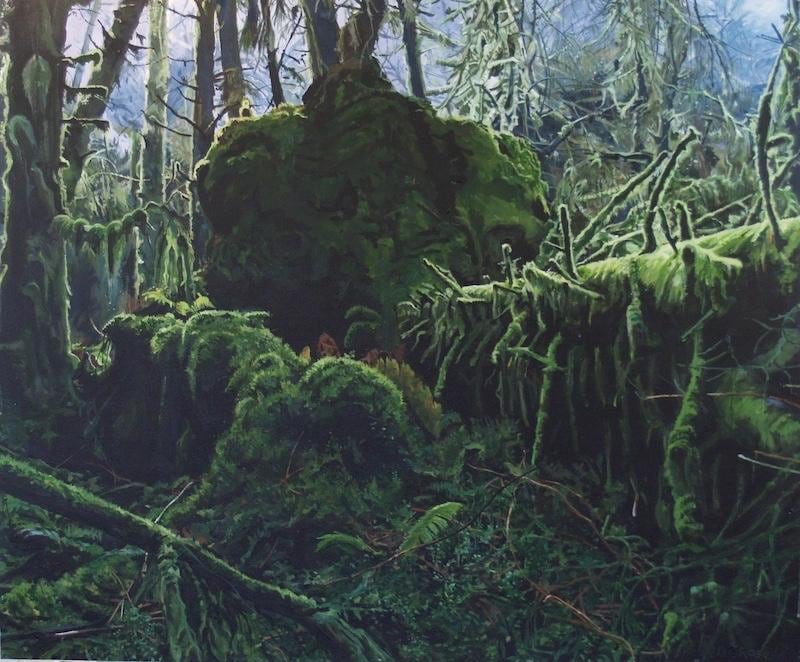Paul Ringrose was born in Dublin and studied art history and archaeology at UCD and also attended NCAD. After painting for several years while living in Co Tipperary, he moved to Berlin and worked in the theatre, designing and painting sets. He was also involved in an environmental consultancy. It’s entirely possible that his time off the island, and in a distinctly inland city, heightened his appreciation of the Irish landscape he had left behind, and perhaps heightened his awareness of the underlying vulnerability of the natural world.
In any case, after his return to Ireland, in time he moved to west Cork and plunged into a rich local landscape of dense, watery woodland. His work was representational – sunlight through dense masses of vegetation, often – but also to some extent abstracted. Emblematic repeat patterns – he said he was interested in camouflage pattern, for example – evoked the processes of growth, decay and renewal in nature, over and above the frozen moment of a photographic view. He liked and responded to the way old woodlands were engines of natural regeneration, each section of forest was a constantly renewing continuum, a habitat supporting a profusion of vegetative and animal life. There was something almost alarming about this burgeoning, unstoppable vitality – he mentions “the violent backlit green” of the woodland – but at its heart was also, he became increasingly aware, an essential fragility that informed the urgency of living things.

Sun cult
Ringrose lives and works within sight of Carrigfadda in west Cork, an old red sandstone hill of modest height but an imposing presence, a classic triangular peak with a rather severe Marian cross perched on its summit, a commemoration of the Marian Year, 1950-51. A large part of the hill is swathed in Sitka spruce.
It is, Ringrose says, regarded as a holy mountain locally, with a pre-Christian cultural history. Traditionally it was visited during the Christmas season. The relatively steep path is stepped for quite a distance. A network of stone circles surrounds the hill. These circles, he reckons, had a religious, ritualistic function in relation to a cult based on the sun – and the moon, as lunar alignments between circles and peak are apparent. Moonlight, he points out, was of much greater relevance to our ancestors than one might imagine in our light-flooded present. He also suspects that the sunset view of the passage tomb on Cape Clear is significant, observing that Carrigfadda’s townland, Carrigagrianane translates as “rock of the sun”.
The forestry plantation dates back about 40 years. Ringrose had been drawn to deciduous woodland, a much richer, more varied environment than monocultural coniferous plantations. As is their wont, the Sitka spruce “quickly grew into a typically brooding mossy pine forest”. Then, eight years ago, a single storm laid waste a large swathe of trees along the crest of the hill. It was soon apparent that the spruce plantation lacked the regenerative potential of a more varied woodland. Instead “the smashed remains” of the trees at Carrigfadda became shrouded in thick carpets of moss, clinging to the fallen wood “in long dripping streels”.
That was only the beginning. A series of storms, “including Ophelia in 2017”, which might once have been exceptional but which are now apparently routine, followed, felling further swathes of trees. Where the process of decay and regeneration in deciduous woodland was cyclical, promising renewal, the damage wrought on the forestry was final and calamitous, as though, as Ringrose puts it, the wood had been bombed. He felt he could not ignore it, that to do so would be to shirk responsibility.

Pollution paintings
Barrie Cooke went through a similar experience at the point when he began to make what became known as his pollution paintings. As a country-dweller and a fisherman, deeply connected to the rural world, he felt it was increasingly unacceptable to ignore the all-too-visible evidence of environmental degradation, especially in relation to water contamination, which he encountered daily. His solution was not to proselytise about it but to address it directly through his work. Paradoxically, as he discovered, there is an ominous, unsettling beauty to processes that are in fact detrimental to the environment.
Ringrose takes a comparable approach. He looks at the reality of the devastated Carrigfadda woodland in exactly the same way he did the thriving deciduous forest. In the paintings we do encounter a shattered domain in which trees have been snapped like matchsticks and enveloped by moss but, as with Cooke’s pollution paintings, there is a muted, sombre beauty to these scenes. Ringrose is very cautiously optimistic in his hope that humans, collectively, might realise the disastrous course they are set on and change direction, and that the process of natural regeneration might be allowed to kick in.
He sees an unfortunate parallel between Carrigfadda and his own long experience of ill health. Not that he is susceptible to pathetic fallacy. Rather the rationale is that his own condition does not excuse him from dealing with what is going on in the world around him, just as individuals in general should not turn away from the monstrous issue of global warming on the basis that their personal contribution is not enough to impact on the problem, given its sheer scale. His own responsibility, as he sees it, is to paint.
Carrigfadda and Me, an exhibition of paintings by Paul Ringrose, is at the Doswell Gallery, West Square, Rosscarbery, Co Cork, until December 23rd doswellgallery.com










